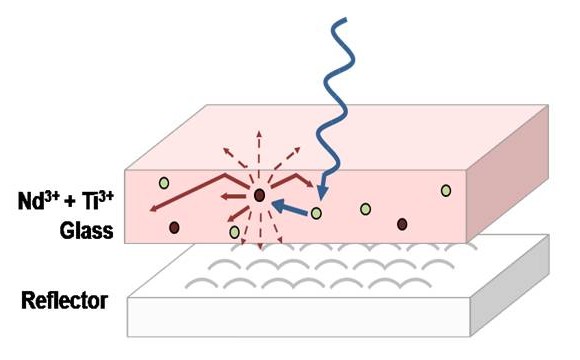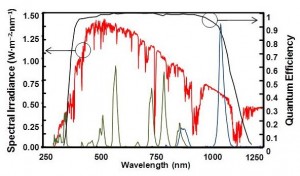Glass-based Luminescent Solar Concentrator

Figure 1: A schematic representation of anLSC. The LSC consists of transition metal (TM) and rare earth (RE) ion doped glass and a diffuse back reflector. Solar radiation incident on the LSC is absorbed by the RE ion and reemitted as infrared radiation. The solar spectrum not absorbed by theREion is captured and transferred by the TM ion and through nonradiative energy transfer to the RE ion.
Photovoltaic solar concentrators aim to increase the electrical power obtained from solar cells. Conventional solar concentrators track the sun to generate high optical intensities, often by using large mobile mirrors that are expensive to deploy and maintain. Solar cells at the focal point of the mirrors must be cooled and the entire assembly wastes space around the perimeter to avoid shadowing neighboring concentrators.
High optical concentrations without excess heating in a stationary system can be achieved with a luminescent solar concentrator (LSC) [1].The LSC consist of a dye dispersed in a transparent waveguide. Incident light is absorbed by the dye and then reemitted into a waveguide mode. The energy difference between absorption and emission prevents reabsorption of light by the dye, isolating the concentrated photon population in the waveguide. Unfortunately, the performance of LSCs has been limited by two factors: self-absorption losses and a scarcity of dyes that absorb and emit efficiently in the infrared region to be coupled to silicon solar cells. We have previouslymade significant progress on the problem of self-absorption losses [2]. Now we address operation in the infrared region.

Figure 2: A comparison between the emission and absorption spectra (a.u.) of Nd3+ (green and blue, respectively); the AM1.5 solar radiation spectrum (red); and the external quantum efficiency of a Sunpower photovoltaic cell (black) [3]
Neodymium (Nd3+) and ytterbium (Yb3+) are nearly the optimal infrared LSC materials: inexpensive, abundant, efficient, and spectrally well-matched to high-performance silicon solar cells. These rare earth ionsare natural four-level systems, reasonably transparent to their own radiation, and therefore capable of generating high optical concentrations. Neodymium’s and ytterbium’s one disadvantage is their relatively poor overlap with the visible spectrum, meaning that the rare earth ions will require sensitization in the visible spectrum, as Figure 2 shows. It has been shown that transition metalscan efficiently transfer energy to these rare earth ions, which will provide the broad sensitization in the required visible and near-infrared region. Finally, these ions can be combined with a high-throughput and chemically robust glass-making process for a low cost and stable LSC.Figure 1 shows a schematic of the system. Sensitized neodymium and ytterbium should enable a LSC matched to silicon with efficiencies exceeding 10%.
References
- W. H. Weber, and J. Lambe,”Luminescent greenhouse collector for solar radiation,” Applied Optics, vol. 15, pp. 2299–2300,October 1976. [↩]
- M. J. Currie, J. K. Mapel, T. D. Heidel, S. Goffri and M. A. Baldo, “High-efficiency organic solar concentrator for photovoltaics,” Science, vol. 321, pp. 226-228, July 2008. [↩]
- W. P. Mulligan, D. H. Rose, M. J. Cudzinovic, D. M. De Ceuster, K. R. McIntosh, D. D. Smith, and R. M. Swanson,“Manufacture of Solar Cells with 21 percent Efficiency,” SunPower Corporation, 2004. [↩]